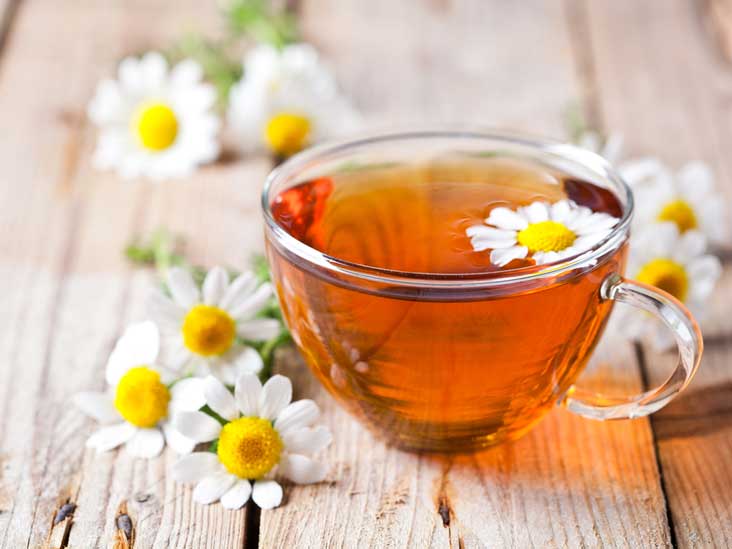

· By Doménica Palacios
The Quali-tea of Chamomile
Welcome to another Quali-tea blog. On this occasion, we are going to discuss and unravel one of our tea ingredients that has actually been around for ages and has been proven to be a great remedy for a large number of stomach and digestive issues. If you didn't know this already, now is probably a good time to tell you that Waku teas don't have any caffeine, that is because we don't use any tea plant or leaves that contain that component. Instead, we went for more natural and healthier options by creating a delicious and incredibly beneficial herb blend that does wonders for your digestion and overall gut health. And of course, we couldn't do this without chamomile. Here are its fun facts, benefits and uses. Enjoy!
What is it?

Chamomile (Matricaria recuita) is a flowering plant in the daisy (Asteraceae) family. Native to Europe and Western Asia, it's now found around the world. The herb smells slightly like an apple, which may explain its name—chamomile is Greek for Earth apple. There are two different chamomile plants: German chamomile and Roman chamomile. German chamomile, which is considered the more potent variety and the type most widely used for medicinal purposes, is the plant discussed here.
Chamomile has been used as a traditional medicine for thousands of years to calm anxiety and settle stomachs. In the U.S., chamomile is best known as an ingredient in herbal tea. It contains chemicals called flavonoids. These flavonoids are a type of nutrient present in many plants, and they play a significant role in chamomile’s medicinal effects.
What are its benefits and nutritional facts?

Chamomile is considered a safe plant and has been used in many cultures for stomach ailments and as a mild sedative. Some studies, primarily using combinations of chamomile with other plants, show it may have health benefits. However, as with any combination product, it is hard to say that a benefit comes from any one plant. The potential benefits of chamomile tea, for which there is the most evidence, include:
Helps reduce menstrual pain: Several studies have linked chamomile tea to reduced severity of menstrual cramps. A 2010 study, for example, found that consuming chamomile tea for a month could reduce the pain of menstrual cramps. Women in the study also reported less anxiety and distress associated with period pain.
Reduces inflammation: Inflammation is an immune system reaction to fight infection. Chamomile tea contains chemical compounds that may reduce inflammationTrusted Source.
Improves Digestive Issues: Preliminary studies suggest that chamomile inhibits Helicobacter pylori, the bacteria that can contribute to stomach ulcers. Chamomile is believed to be helpful in reducing smooth muscle spasms associated with various gastrointestinal inflammatory disorders like inflammatory bowel disease, though research is needed to confirm that use.
How is it used or how could it be prepared?

Chamomile flowers are a common ingredient in teas. They're also used as a flavoring in other foods and drinks. The flowering tops of the chamomile plant are used to make teas, liquid extracts, capsules, or tablets. The herb can also be applied to the skin as a cream or an ointment, or used as a mouth rinse.
To make tea, steep one heaping teaspoon of chamomile flowers in two-thirds of a cup of boiling water for five to 10 minutes before straining. You can also buy commercial teas and it is also available in capsules.
As a gargle or mouth rinse, prepare as a tea, then let it cool. Gargle as often as desired. You may also make an oral rinse with 10 to 15 drops of German chamomile liquid extract (aka tincture) in 100 milliliters of warm water.
There is no standard dosage of chamomile. Dosages used in studies vary. For instance, capsules containing 220 to 1100 milligrams of German chamomile extract have been taken daily for eight weeks to help alleviate anxiety.
Adverse Effects
Chamomile is part of the same plant family as ragweed and chrysanthemum, so people with allergies to these plants may react—sometimes severely—when they use chamomile either internally or topically. Due to concerns about bleeding, chamomile shouldn't be used two weeks before or after surgery.
Most experts say chamomile is safe. It can cause drowsiness and, in large doses, vomiting. It also has the potential to trigger allergic reactions in people who are allergic to related plants in the daisy family, although such reactions are very rare. Avoid it if you are allergic to these plants: chamomile, ragweed, daisies, marigolds, or chrysanthemums.
It is also not safe to use chamomile as a substitute for proven medical treatments. If someone is taking any medications, they should ask their doctor about potential interactions with chamomile tea. Keep in mind that chamomile in any form should be used as a supplement to, and not a replacement for, your usual medication regimen. Talk to your healthcare providers before taking chamomile if you’re taking any type of medicine. Giving them a full picture of what you do to manage your health will help to ensure coordinated and safe care.
References: